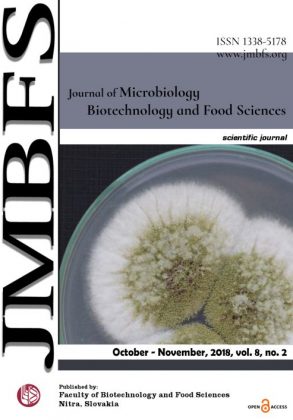INHIBITORY EFFECT OF ESSENTIAL OILS FROM SOME LAMIACEAE SPECIES ON GROWTH OF EUROTIUM SPP. ISOLATED FROM BREAD
DOI:
https://doi.org/10.15414/jmbfs.2018.8.2.857-862Keywords:
antifungal activity, bread, Eurotium, essential oils, vaporAbstract
Bread is considered an intermediate - moisture food product that is prone to mould spoilage. Growth of spoilage fungi is currently controlled with the addition of chemical preservatives. Consumers demand more natural products and there is a need to reduce the amount of chemical preservatives added to foods. Essential oils (EOs) and their constituents emerged as promising and effective compounds to protect foods from lipid peroxidation and provide microbiological food safety. So the aim of our study was to determinate microscopic fungi involved in contamination of bread target the genus Eurotium and to evaluate the antifungal activity of 5 EOs by vapor contact against the fungal species of this genus. In all samples after three days of cultivation fungi created colonies on the surface of the crust and the pieces of the bread samples stored on DRBC were after three days of cultivation covered with fungi colonies. Altogether 195 isolates were recovered from 8 bread samples and assigned to 10 fungal genera. The most frequently genus of fungi was Penicillium, Aspergillus, Cladosporium, Epicoccum and Eurotium. Based on phylogenetic and morphological studies, five different Eurotium species were identified: E. amstelodami, E. chevalieri, E. herbariorum, E. rubrum and E. repens. In this study, we explored the potential of five essential oils retrieved from some Lamiaceae species, concretely: basil (Ocinum basilicum L.), lavender (Lavandula angustifolia Mill.), oregano (Origanum vulgare L.), mint (Metha piperita L.) and sage (Salvia officinalis L.). Gas chromatography–mass spectrometry (GC-MS) analysis allowed for the identification of 28 compounds as main constituents. Inhibitory activity of EOs was assessed against 5 species of genus Eurotium (2 isolates for each specie). In all studied strains, the essential oils caused significant differences (P<0.05) on the mycelium growth. Our result showed that the best antifungal effect was shown by lavender and oregano (100%) to all species of tested fungi followed by mint (with the best MGI 79.89% to E. rubrum) >basil (with the best Mycelial growth Inhibition (MGI) 93.65% to E. herbariorum) and the low effect had sage essential oil (with the best MGI 68.62% to E. repens). The present study demonstrated the potential food preservative ability of essential oils from some Lamiaceae species.Downloads
Download data is not yet available.
Downloads
Published
2018-10-01
How to Cite
CÃsarová, M., Hleba, L., TanÄinová, D., Florková, M., Foltinová, D., Charousová, I., Vrbová, K., Božik, M., & KlouÄek, P. (2018). INHIBITORY EFFECT OF ESSENTIAL OILS FROM SOME LAMIACEAE SPECIES ON GROWTH OF EUROTIUM SPP. ISOLATED FROM BREAD. Journal of Microbiology, Biotechnology and Food Sciences, 8(2), 857–862. https://doi.org/10.15414/jmbfs.2018.8.2.857-862
Issue
Section
Microbiology
License
Copyright (c) 2018 Miroslava CÃsarová, Lukáš Hleba, Dana TanÄinová, Mária Florková, Denisa Foltinová, Ivana Charousová, KristÃÂna Vrbová, Matěj Božik, Pavel KlouÄek

This work is licensed under a Creative Commons Attribution 4.0 International License.
All papers published in the Journal of Microbiology, Biotechnology and Food Sciences are published under a CC-BY licence (CC-BY 4.0). Published materials can be shared (copy and redistribute the material in any medium or format) and adapted (remix, transform, and build upon the material for any purpose, even commercially) with specifying the author(s).





